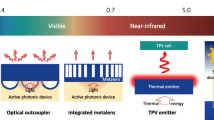Abstract
In this article, we report a hybrid quantum–classical design of Fabry–Perot multilayer cavities. Such design starts from an ab initio calculation of the dielectric function for each semiconducting layer with a specific atomic structure, followed by a study of wave scattering through the device using the transfer matrix method within the classical electromagnetic theory. This optical cavity consists of two multilayer reflectors separated by a single impurity layer, which is tuned to exhibit a resonant peak at the center of reflection band. The validation of this multiscale design was carried out on a freestanding nanostructured porous silicon multilayer film fabricated by electrochemical etching of a highly-doped p-type [100]-oriented crystalline Si wafer alternating two anodic current densities and finishing with a high current to separate the multilayer from the substrate. The measured infrared transmittance spectra are compared with those predicted from the hybrid design.



Similar content being viewed by others
References
C. Fabry, A. Pérot, Théorie et applications d’une nouvelle méthode de spectroscopie interférentielle, Ann. Chim. Phys. 16 (7), 115–144 (1899)
A. Pérot, C. Fabry, On the application of interference phenomena to the solution of various problems of spectroscopy and metrology, Astrophys. J. 9, 87–115 (1899)
M. Vignaux, F. Lemarchand, C. Grezes-Besset, J. Lumeau, In situ optical monitoring of Fabry-Perot multilayer structures: analysis of current techniques and optimized procedures. Opt. Express 25, 18040–18055 (2017)
Y.-J. Jen, M.-J. Lin, Design and fabrication of a narrow bandpass filter with low dependence on angle of incidence. Coatings 8(7), 231 (2018)
M.S. Rauscher, M. Schardt, M.H. Köhler, A.W. Koch, Dual-channel mid-infrared sensor based on tunable Fabry–Perot filters for fluid monitoring applications, Sens. Actuators B Chem. 259, 420–427 (2018)
R.G. Parr, W. Yang, Density-Functional Theory of Atoms and Molecules (Oxford University Press, Oxford, 1989)
P. Yeh, Optical Waves in Layered Media (Wiley, Hoboken, 2005), pp. 58–64 and 102
L. Canham, Handbook of Porous Silicon, 2nd edn. (Springer, Berlin, 2018)
R. Cisneros, C. Ramírez, C. Wang, Ellipsometry and ab initio approaches to the refractive index of porous silicon. J. Phys. 19, 395010 (2007)
R. Del Sole, R. Girlanda, Optical properties of semiconductors within the independent-quasiparticle approximation. Phys. Rev. B 48, 11789 (1993)
Y. Bonder, C. Wang, A first-principles model of birefringent porous silicon. J. Appl. Phys. 100, 044319 (2006)
P. Alfaro, A. Palavicini, C. Wang, Hydrogen, oxygen and hydroxyl on porous silicon surface: A joint density-functional perturbation theory and infrared spectroscopy approach. Thin Solid Films 571, 206 (2014)
M.D. Segall, P.J.D. Lindan, M.J. Probert, C.J. Pickcard, P.J. Hasnip, S.J. Clark, M.C. Payne, First-principles simulation: ideas, illustrations and the CASTEP code. J. Phys. 14, 2717 (2002)
J. Barzilai, J.M. Borwein, 2-Point step size gradient methods. IMA J. Numer. Anal. 8, 141–148 (1988)
T.C. Choy, Effective Medium Theory. Principles and Applications (Oxford University Press, New York, 1999)
A. Palavicini, C. Wang, Ab-initio determination of porous silicon refractive index confirmed by infrared transmittance measurements of an omnidirectional multilayer reflector. Appl. Phys. B 124, 65 (2018)
V.P. Tolstoy, I.V. Chernyshova, V.A. Skryshevsky, Handbook of Infrared Spectroscopy of Ultrathin Films (Wiley, Hoboken, 2003), p. 452
Acknowledgements
We would like to thank Alberto López, Alejandro Pompa and Yolanda Flores for their technical assistance. This work has been partially supported by UNAM-IN106317 and CONACyT-252943. Computations were performed at Miztli of DGTIC, UNAM.
Author information
Authors and Affiliations
Corresponding author
Additional information
Publisher’s Note
Springer Nature remains neutral with regard to jurisdictional claims in published maps and institutional affiliations.
Rights and permissions
About this article
Cite this article
Palavicini, A., Wang, C. Ab initio design and experimental confirmation of Fabry–Perot cavities based on freestanding porous silicon multilayers. J Mater Sci: Mater Electron 31, 60–64 (2020). https://doi.org/10.1007/s10854-019-01037-1
Received:
Accepted:
Published:
Issue Date:
DOI: https://doi.org/10.1007/s10854-019-01037-1




